Deck 13: Producer Choices and Constraints
Question
Question
Question
Question
Question
Question
Question
Question
Question
Question
Question
Question
Question
Question
Question
Question
Question
Question
Question
Question
Question
Question
Question
Question
Question
Question
Question
Question
Question
Question
Question
Question
Question
Question
Question
Question
Question
Question
Question
Question
Question
Question
Question
Question
Question
Question
Question
Question
Question
Question
Question
Question
Question
Question
Question
Question
Question
Question
Question
Question
Question
Question
Question
Question
Question
Question
Question
Question
Question
Question
Question
Question
Question
Question
Question
Question
Question
Question
Question
Question

Unlock Deck
Sign up to unlock the cards in this deck!
Unlock Deck
Unlock Deck
1/140
Play
Full screen (f)
Deck 13: Producer Choices and Constraints
1
Which of the following costs are part of a firm's opportunity costs?
I. Costs of resources bought in markets.
II. Costs of resources the firm owns.
III. Costs of resources supplied by the owner.
A) I only
B) I and III
C) I and II
D) I, II and III
I. Costs of resources bought in markets.
II. Costs of resources the firm owns.
III. Costs of resources supplied by the owner.
A) I only
B) I and III
C) I and II
D) I, II and III
I, II and III
2
A firm's opportunity costs _______.
A) increase when economies of scope exist
B) include the cost of using resources owned by the firm
C) equal the cost of resources it buys from others in the market
D) do not include any opportunity costs for resources the owner suppliers
A) increase when economies of scope exist
B) include the cost of using resources owned by the firm
C) equal the cost of resources it buys from others in the market
D) do not include any opportunity costs for resources the owner suppliers
include the cost of using resources owned by the firm
3

The cost data in the above table show that production is characterised by
A) constant returns to scale.
B) decreasing returns to scale.
C) economies of scale.
D) More information is needed to answer the question.
economies of scale.
4
A firm's marginal cost is the change in its total cost divided by the change in its
A) average revenue.
B) average cost.
C) output.
D) quantity of labour.
A) average revenue.
B) average cost.
C) output.
D) quantity of labour.

Unlock Deck
Unlock for access to all 140 flashcards in this deck.
Unlock Deck
k this deck
5

Cindy's Shirts' production function is shown in the above table. Cindy rents two sewing machines for $30 a day each and hires workers at a wage rate of $40 a day per worker. If Cindy produces 18 sweaters per day, what is her average total cost?
A) $10.00
B) $13.33
C) $6.67
D) $11.00

Unlock Deck
Unlock for access to all 140 flashcards in this deck.
Unlock Deck
k this deck
6
Which of the following statements is true?
A) The marginal and average product curves intersect at the maximum level of output.
B) The marginal product curve always has a positive slope.
C) At every output level the marginal product curve lies above the average product curve.
D) The marginal product and average product curves intersect when average product is at its maximum.
A) The marginal and average product curves intersect at the maximum level of output.
B) The marginal product curve always has a positive slope.
C) At every output level the marginal product curve lies above the average product curve.
D) The marginal product and average product curves intersect when average product is at its maximum.

Unlock Deck
Unlock for access to all 140 flashcards in this deck.
Unlock Deck
k this deck
7
Tudor's Deli and Catering could have sold their delivery van on December 31, 2010 for $16,000. If they could sell the same van on December 31, 2011 for $13,000, then the economic depreciation in 2011 for this van
A) is $29,000.
B) is $13,000.
C) is $16,000.
D) is $3,000.
A) is $29,000.
B) is $13,000.
C) is $16,000.
D) is $3,000.

Unlock Deck
Unlock for access to all 140 flashcards in this deck.
Unlock Deck
k this deck
8
Total variable cost is the sum of all
A) costs associated with the production of goods.
B) costs that rise as output increases.
C) implicit costs.
D) costs of the firm's fixed factors of production.
A) costs associated with the production of goods.
B) costs that rise as output increases.
C) implicit costs.
D) costs of the firm's fixed factors of production.

Unlock Deck
Unlock for access to all 140 flashcards in this deck.
Unlock Deck
k this deck
9
When the total product curve is drawn in a figure that measures employment along the horizontal axis, it is a graph that shows the
A) minimum output attainable for each quantity of labour employed.
B) maximum output attainable for each quantity of labour employed.
C) minimum cost of producing a given amount of output using different techniques.
D) maximum profit attainable for each unit of output sold per unit of labour employed.
A) minimum output attainable for each quantity of labour employed.
B) maximum output attainable for each quantity of labour employed.
C) minimum cost of producing a given amount of output using different techniques.
D) maximum profit attainable for each unit of output sold per unit of labour employed.

Unlock Deck
Unlock for access to all 140 flashcards in this deck.
Unlock Deck
k this deck
10
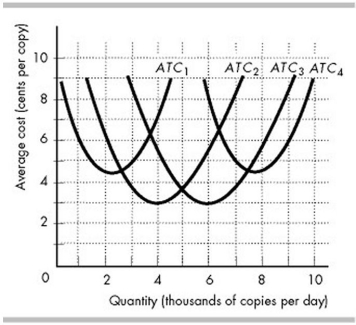
Dustin's copy shop can use four alternative plants. The figure above shows the average total cost curves for Plant 1 (ATC1), Plant 2 (ATC2), Plant 3 (ATC3), and Plant 4 (ATC4). Dustin's minimum efficient scale is
A) 4,000 copies per day.
B) 6,000 copies per day.
C) 2,650 copies per day.
D) More information is needed to determine the minimum efficient scale.

Unlock Deck
Unlock for access to all 140 flashcards in this deck.
Unlock Deck
k this deck
11
Ernie's Earmuffs produces 200 earmuffs per year at a total cost of $2,000 and $400 of this cost is fixed. If he increases output to 220 earmuffs, his total cost increases to $2100, and his fixed cost remains $400. What is Ernie's marginal cost per earmuff?
A) $9.55
B) $5
C) $35
D) $105
A) $9.55
B) $5
C) $35
D) $105

Unlock Deck
Unlock for access to all 140 flashcards in this deck.
Unlock Deck
k this deck
12

The table above shows the short- run product schedule for Virginia's T- Shirts. The worker for whom the law of diminishing marginal returns initially occurs is the _______ worker.
A) 2nd
B) 3rd
C) 5th
D) 4th

Unlock Deck
Unlock for access to all 140 flashcards in this deck.
Unlock Deck
k this deck
13
Which of the following would be classified as a fixed cost for the local supermarket?
A) The rent for the six- year lease for the building the store uses
B) The cost of the boxes of cereal sold in the store
C) The payroll tax the store pays the government on the workers' income
D) The salary and any overtime paid to the store's manager
A) The rent for the six- year lease for the building the store uses
B) The cost of the boxes of cereal sold in the store
C) The payroll tax the store pays the government on the workers' income
D) The salary and any overtime paid to the store's manager

Unlock Deck
Unlock for access to all 140 flashcards in this deck.
Unlock Deck
k this deck
14
The law of diminishing marginal returns states that as
A) a firm uses more of a variable input, given the quantity of fixed inputs, the marginal product of the variable input eventually diminishes.
B) a firm uses more of a variable input, given the quantity of fixed inputs, the firm's average total cost will decrease eventually.
C) the size of a plant increases, the firm's fixed costs decrease.
D) the size of a plant increases, the firm's fixed costs increase.
A) a firm uses more of a variable input, given the quantity of fixed inputs, the marginal product of the variable input eventually diminishes.
B) a firm uses more of a variable input, given the quantity of fixed inputs, the firm's average total cost will decrease eventually.
C) the size of a plant increases, the firm's fixed costs decrease.
D) the size of a plant increases, the firm's fixed costs increase.

Unlock Deck
Unlock for access to all 140 flashcards in this deck.
Unlock Deck
k this deck
15
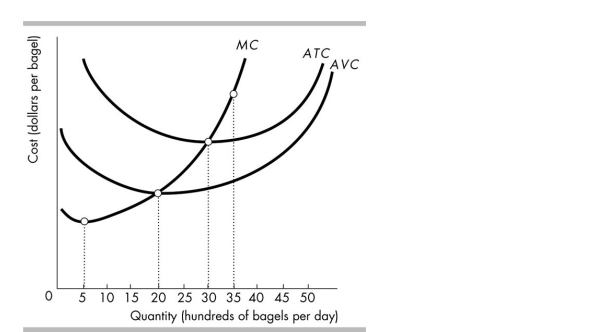
The above figure shows the costs at Barney's Bagel Bakery. Up to which level of output will increasing marginal returns in production be experienced at Barney's Bagel Bakery?
A) Up to 2,000 bagels
B) Up to 3,000 bagels
C) Up to 500 bagels
D) Up to 3,500 bagels

Unlock Deck
Unlock for access to all 140 flashcards in this deck.
Unlock Deck
k this deck
16

In the figure above, curve C is the _______ curve.
A) average fixed cost
B) marginal cost
C) average variable cost
D) average total cost

Unlock Deck
Unlock for access to all 140 flashcards in this deck.
Unlock Deck
k this deck
17
When long- run average cost decreases as output increases there are definitely
I. increasing marginal returns.
II. economies of scale.
A) Only I
B) Only II
C) Both I and II
D) Neither I nor II
I. increasing marginal returns.
II. economies of scale.
A) Only I
B) Only II
C) Both I and II
D) Neither I nor II

Unlock Deck
Unlock for access to all 140 flashcards in this deck.
Unlock Deck
k this deck
18
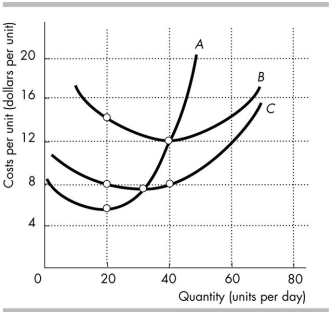
In the figure above, when 20 units are produced the marginal cost is
A) less than $8.
B) more than $8 and less than $16.
C) $8.
D) None of the above answers is correct.

Unlock Deck
Unlock for access to all 140 flashcards in this deck.
Unlock Deck
k this deck
19
The average return for supplying entrepreneurial ability is the entrepreneur's
A) explicit profit.
B) economic profit.
C) accounting profit.
D) normal profit.
A) explicit profit.
B) economic profit.
C) accounting profit.
D) normal profit.

Unlock Deck
Unlock for access to all 140 flashcards in this deck.
Unlock Deck
k this deck
20
The law of diminishing marginal returns states that as the firm uses more of _______, with a given quantity of _______, the _______ product of the variable input eventually diminishes.
A) all inputs; capital; average
B) a variable input; fixed inputs; average
C) a fixed input; variable inputs; marginal
D) a variable input; fixed inputs; marginal
A) all inputs; capital; average
B) a variable input; fixed inputs; average
C) a fixed input; variable inputs; marginal
D) a variable input; fixed inputs; marginal

Unlock Deck
Unlock for access to all 140 flashcards in this deck.
Unlock Deck
k this deck
21

The table above shows some data that describes Tom's T- Shirts' total product when Tom has one sewing machine. When 4 workers are employed, _______.
A) average product of labour is at the maximum
B) marginal product of labour equals average product of labour
C) marginal product of labour exceeds average product of labour
D) marginal product of labour is less than average product of labour

Unlock Deck
Unlock for access to all 140 flashcards in this deck.
Unlock Deck
k this deck
22

Using the data in the above table, what is the average product of three employees?
A) 12 pizzas per hour.
B) 4 pizzas per hour.
C) 3 pizzas per hour.
D) 2 pizzas per hour.

Unlock Deck
Unlock for access to all 140 flashcards in this deck.
Unlock Deck
k this deck
23
The implicit rental rate for capital includes the
A) firm's normal profit.
B) interest income forgone by purchasing the piece of capital equipment.
C) total value of a piece of capital equipment.
D) amount paid for the use of a piece of capital equipment owned by someone else.
A) firm's normal profit.
B) interest income forgone by purchasing the piece of capital equipment.
C) total value of a piece of capital equipment.
D) amount paid for the use of a piece of capital equipment owned by someone else.

Unlock Deck
Unlock for access to all 140 flashcards in this deck.
Unlock Deck
k this deck
24
Greg, a landscaper, is planning on opening his own landscaping company. He currently earns
$40,000 per year working for his uncle but he will need to quit that job. He plans to use $10,000 in savings to pay for the equipment he needs, although even after use he could sell the equipment for what he paid, $10,000. The current interest rate on savings is 5 per cent. What is the total opportunity cost incurred by Greg in running his own business?
A) $50,000
B) $40,500
C) $10,000
D) $40,000
$40,000 per year working for his uncle but he will need to quit that job. He plans to use $10,000 in savings to pay for the equipment he needs, although even after use he could sell the equipment for what he paid, $10,000. The current interest rate on savings is 5 per cent. What is the total opportunity cost incurred by Greg in running his own business?
A) $50,000
B) $40,500
C) $10,000
D) $40,000

Unlock Deck
Unlock for access to all 140 flashcards in this deck.
Unlock Deck
k this deck
25
Points below a firm's total product curve are
A) technologically efficient but not attainable.
B) attainable but not technologically efficient.
C) both attainable and technologically efficient.
D) neither attainable nor technologically efficient.
A) technologically efficient but not attainable.
B) attainable but not technologically efficient.
C) both attainable and technologically efficient.
D) neither attainable nor technologically efficient.

Unlock Deck
Unlock for access to all 140 flashcards in this deck.
Unlock Deck
k this deck
26
The short run is a period of time in which
A) the quantities used of all factors of production are fixed.
B) the quantity used of at least one factor of production is fixed.
C) factor of production prices are fixed.
D) output prices are fixed.
A) the quantities used of all factors of production are fixed.
B) the quantity used of at least one factor of production is fixed.
C) factor of production prices are fixed.
D) output prices are fixed.

Unlock Deck
Unlock for access to all 140 flashcards in this deck.
Unlock Deck
k this deck
27
Which of the following statements is true?
A) Average total cost always falls as output increases.
B) Average fixed cost equals total fixed cost divided by total output.
C) Average fixed cost equals average total cost plus average variable cost.
D) Average variable cost is always greater than average fixed cost.
A) Average total cost always falls as output increases.
B) Average fixed cost equals total fixed cost divided by total output.
C) Average fixed cost equals average total cost plus average variable cost.
D) Average variable cost is always greater than average fixed cost.

Unlock Deck
Unlock for access to all 140 flashcards in this deck.
Unlock Deck
k this deck
28
The implicit rental rate for capital is
A) a cost that is irrelevant to the business.
B) an opportunity cost.
C) an accounting cost.
D) part of the firm's normal profit.
A) a cost that is irrelevant to the business.
B) an opportunity cost.
C) an accounting cost.
D) part of the firm's normal profit.

Unlock Deck
Unlock for access to all 140 flashcards in this deck.
Unlock Deck
k this deck
29

The table above shows the short- run product schedule for Virginia's T- Shirts. What is the marginal product associated with hiring the fifth worker?
A) 50 shirts
B) 235 shirts
C) 30 shirts
D) 250 shirts

Unlock Deck
Unlock for access to all 140 flashcards in this deck.
Unlock Deck
k this deck
30
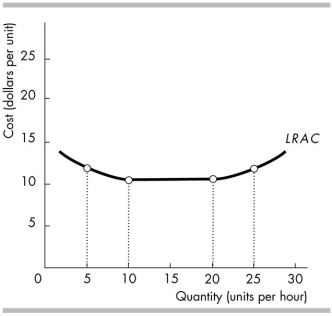
In the above figure, between 20 and 25 units per hour, the firm experiences
A) economies of scale.
B) constant returns to scale.
C) increasing total fixed costs.
D) diseconomies of scale.

Unlock Deck
Unlock for access to all 140 flashcards in this deck.
Unlock Deck
k this deck
31
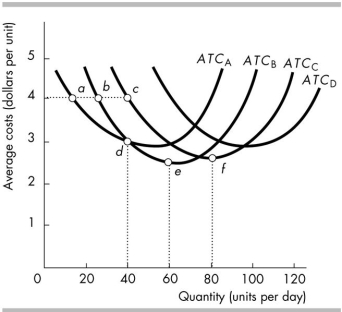
The average total cost curves for plants A, B, C and D are shown in the above figure. Which plant is BEST to use to produce 20 units per day?
A) Plant A
B) Plant B
C) Plant C
D) Plant D

Unlock Deck
Unlock for access to all 140 flashcards in this deck.
Unlock Deck
k this deck
32
When long- run average cost remains constant as output increases there are constant
A) diseconomies of scale.
B) economies of scale.
C) returns to scale.
D) marginal returns.
A) diseconomies of scale.
B) economies of scale.
C) returns to scale.
D) marginal returns.

Unlock Deck
Unlock for access to all 140 flashcards in this deck.
Unlock Deck
k this deck
33
Farmer Seth has a perfectly flat long- run average total cost curve over the range of output from 1,000 tonnes of wheat to 10,000 tonnes of wheat. Hence, over this range of output, Farmer Seth definitely experiences
A) constant economies of scale.
B) constant returns to scale.
C) constant marginal returns.
D) None of the above.
A) constant economies of scale.
B) constant returns to scale.
C) constant marginal returns.
D) None of the above.

Unlock Deck
Unlock for access to all 140 flashcards in this deck.
Unlock Deck
k this deck
34
Suppose Pippi buys an oven for her pizza parlour for $100,000. Pippi's pizza tasted so pitiful she went out of business 12 months later. She was able to sell the pizza oven for $75,000. This decrease in the value of the oven is
A) economic depreciation.
B) the total implicit rental rate on the oven.
C) interest forgone.
D) an economic loss.
A) economic depreciation.
B) the total implicit rental rate on the oven.
C) interest forgone.
D) an economic loss.

Unlock Deck
Unlock for access to all 140 flashcards in this deck.
Unlock Deck
k this deck
35
The steeper the slope of the total product curve, the
A) higher is the level of the total cost curve.
B) larger is the marginal product of labour.
C) smaller is the marginal product of labour.
D) more efficient is the technology employed.
A) higher is the level of the total cost curve.
B) larger is the marginal product of labour.
C) smaller is the marginal product of labour.
D) more efficient is the technology employed.

Unlock Deck
Unlock for access to all 140 flashcards in this deck.
Unlock Deck
k this deck
36
When the marginal product curve is above the average product curve, _______as output increases.
A) marginal product must decrease
B) average product must increase
C) marginal product must increase
D) average product must decrease
A) marginal product must decrease
B) average product must increase
C) marginal product must increase
D) average product must decrease

Unlock Deck
Unlock for access to all 140 flashcards in this deck.
Unlock Deck
k this deck
37
The law of diminishing marginal returns occurs because
A) the marginal product of a variable input, such as labour, depends in part on the amount of fixed inputs, such as capital.
B) the marginal product of an additional worker is greater than the marginal product of the previous worker.
C) total production decreases as more of the variable inputs are used.
D) adding more and more workers leads to a decrease in the quantity of capital.
A) the marginal product of a variable input, such as labour, depends in part on the amount of fixed inputs, such as capital.
B) the marginal product of an additional worker is greater than the marginal product of the previous worker.
C) total production decreases as more of the variable inputs are used.
D) adding more and more workers leads to a decrease in the quantity of capital.

Unlock Deck
Unlock for access to all 140 flashcards in this deck.
Unlock Deck
k this deck
38
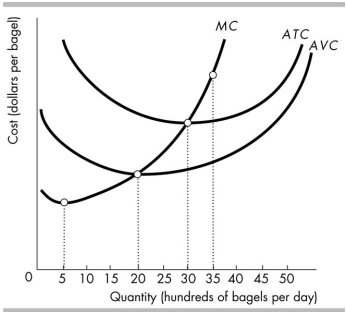
The above figure shows the costs at Barney's Bagel Bakery. After 3,000 bagels are produced each day, the ATC curve starts to slope upward because the
A) MC curve slopes upward.
B) AFC curve (not shown) starts to slope upward
C) MC exceeds the ATC.
D) None of the above answers is correct.

Unlock Deck
Unlock for access to all 140 flashcards in this deck.
Unlock Deck
k this deck
39
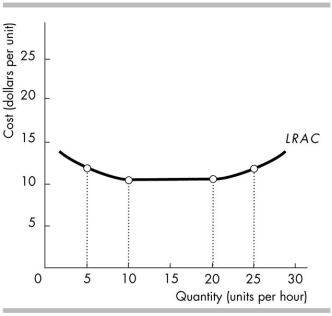
In the above figure, the long- run average cost curve exhibits economies of scale
A) along the entire curve.
B) between 10 and 20 units per hour.
C) between 20 and 25 units per hour.
D) between 5 and 10 units per hour.

Unlock Deck
Unlock for access to all 140 flashcards in this deck.
Unlock Deck
k this deck
40
By using more labour to produce more output, a firm can always reduce its
A) average fixed cost.
B) marginal cost.
C) average total cost.
D) average variable cost.
A) average fixed cost.
B) marginal cost.
C) average total cost.
D) average variable cost.

Unlock Deck
Unlock for access to all 140 flashcards in this deck.
Unlock Deck
k this deck
41

Cindy's Shirts' production function is shown in the above table. Cindy rents two sewing machines for $30 a day each and hires workers at a daily wage rate of $40 per worker. What is the marginal cost when production increases from 18 to 20 units per day?
A) $40.00
B) $10.00
C) $20.00
D) $8.00

Unlock Deck
Unlock for access to all 140 flashcards in this deck.
Unlock Deck
k this deck
42
If a firm's marginal product of labour is less than its average product of labour, then an increase in the quantity of labour it employs definitely will
A) decrease its total product.
B) decrease its average product of labour.
C) not change its average product of labour.
D) increase its marginal product of labour.
A) decrease its total product.
B) decrease its average product of labour.
C) not change its average product of labour.
D) increase its marginal product of labour.

Unlock Deck
Unlock for access to all 140 flashcards in this deck.
Unlock Deck
k this deck
43
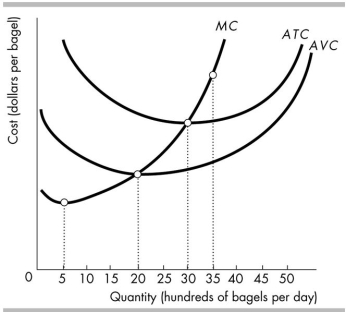
The above figure shows the costs at Barney's Bagel Bakery. At which of the following amounts of output is the AFC at its lowest?
A) At 3,500 bagels
B) At 2,000 bagels
C) At 3,000 bagels
D) None of the above because the AFC is constant regardless of how many bagels are produced each day.

Unlock Deck
Unlock for access to all 140 flashcards in this deck.
Unlock Deck
k this deck
44
Economic profit is the difference between total revenue and
A) the cost of resources bought in markets.
B) opportunity costs of production.
C) interest costs of production.
D) the normal profit.
A) the cost of resources bought in markets.
B) opportunity costs of production.
C) interest costs of production.
D) the normal profit.

Unlock Deck
Unlock for access to all 140 flashcards in this deck.
Unlock Deck
k this deck
45
A firm experiences _______ when its _______ downward as output increases.
A) economies of scale; long- run average cost curve slopes
B) diminishing marginal returns; long- run average cost curve slopes
C) diminishing marginal returns; average total cost curve shifts
D) diseconomies of scale; average total cost curve slopes
A) economies of scale; long- run average cost curve slopes
B) diminishing marginal returns; long- run average cost curve slopes
C) diminishing marginal returns; average total cost curve shifts
D) diseconomies of scale; average total cost curve slopes

Unlock Deck
Unlock for access to all 140 flashcards in this deck.
Unlock Deck
k this deck
46
Which of the following is correct?
A) A firm's long- run average cost curve is derived from a series of short- run average cost curves.
B) A firm's long- run total cost is the difference between its long- run fixed cost and long- run variable cost.
C) A firm's short- run average cost curve is derived from a series of long- run average cost curves.
D) Both answers A and C are correct.
A) A firm's long- run average cost curve is derived from a series of short- run average cost curves.
B) A firm's long- run total cost is the difference between its long- run fixed cost and long- run variable cost.
C) A firm's short- run average cost curve is derived from a series of long- run average cost curves.
D) Both answers A and C are correct.

Unlock Deck
Unlock for access to all 140 flashcards in this deck.
Unlock Deck
k this deck
47
Bud opened a flower shop. He rented a building for $9,000 a year. To buy equipment for the store, he withdrew $10,000 from his savings account, which earned an annual interest rate of 3 per cent. During the first year of operation, Bud paid $4,000 for utilities and $12,000 to his suppliers. The store's total annual revenue was $55,000. The market value of the store's equipment at the end of the year was $8,000. If Bud had not started this business, he would have continued to work as an employee at another flower shop for $30,000 a year. During the first year of operation, Bud
A) received an economic profit of $20,000.
B) incurred an economic loss of $2,300.
C) received an economic profit of $30,000.
D) incurred an economic loss of $12,300.
A) received an economic profit of $20,000.
B) incurred an economic loss of $2,300.
C) received an economic profit of $30,000.
D) incurred an economic loss of $12,300.

Unlock Deck
Unlock for access to all 140 flashcards in this deck.
Unlock Deck
k this deck
48
Most total product curves have
A) output first increasing and then decreasing as labour is added.
B) output increasing at an increasing rate as labour is added.
C) first decreasing and then increasing marginal returns to labour.
D) first increasing and then decreasing marginal returns to labour.
A) output first increasing and then decreasing as labour is added.
B) output increasing at an increasing rate as labour is added.
C) first decreasing and then increasing marginal returns to labour.
D) first increasing and then decreasing marginal returns to labour.

Unlock Deck
Unlock for access to all 140 flashcards in this deck.
Unlock Deck
k this deck
49
A firm's average total cost is $60, its average variable cost is $30, and its total fixed cost is $600. Its output is
A) 50 units.
B) 20 units.
C) 40 units.
D) 30 units.
A) 50 units.
B) 20 units.
C) 40 units.
D) 30 units.

Unlock Deck
Unlock for access to all 140 flashcards in this deck.
Unlock Deck
k this deck
50

Using the data in the above table, what is the marginal product of the second worker?
A) 4.5 pizzas per hour
B) 5 pizzas per hour
C) 4 pizzas per hour
D) The marginal product is undefined.

Unlock Deck
Unlock for access to all 140 flashcards in this deck.
Unlock Deck
k this deck
51
Ernie's Earmuffs produces 200 earmuffs per year at a total cost of $2,000 and $400 of this cost is fixed. What is Ernie's average total cost?
A) $2
B) $10
C) $12
D) $8
A) $2
B) $10
C) $12
D) $8

Unlock Deck
Unlock for access to all 140 flashcards in this deck.
Unlock Deck
k this deck
52
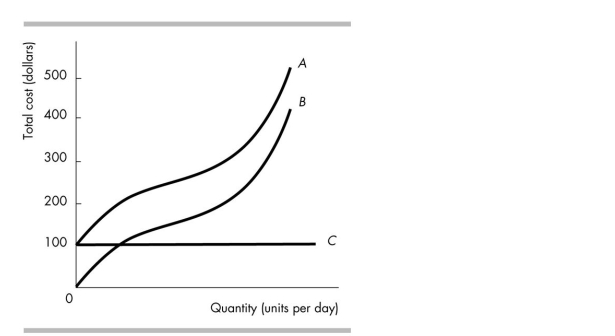
In the above figure, the total variable cost curve is curve
A) A.
B) B.
C) C.
D) None of the curves in the figure.

Unlock Deck
Unlock for access to all 140 flashcards in this deck.
Unlock Deck
k this deck
53
The total output produced with any quantity of labour is equal to the sum of the
A) marginal products of each of the workers hired.
B) total wages the firm pays its workers.
C) average products of each of the workers hired.
D) Both answers A and B are correct.
A) marginal products of each of the workers hired.
B) total wages the firm pays its workers.
C) average products of each of the workers hired.
D) Both answers A and B are correct.

Unlock Deck
Unlock for access to all 140 flashcards in this deck.
Unlock Deck
k this deck
54
Total product is
A) the maximum output that a given quantity of labour can produce.
B) the increase in output that results from a one- unit increase in the quantity of labour employed with all other inputs remaining the same.
C) the maximum amount of output produced by a given quantity of labour divided by the given quantity of labour employed.
D) the maximum amount of amount of output produced by a given quantity of labour divided by price of the output.
A) the maximum output that a given quantity of labour can produce.
B) the increase in output that results from a one- unit increase in the quantity of labour employed with all other inputs remaining the same.
C) the maximum amount of output produced by a given quantity of labour divided by the given quantity of labour employed.
D) the maximum amount of amount of output produced by a given quantity of labour divided by price of the output.

Unlock Deck
Unlock for access to all 140 flashcards in this deck.
Unlock Deck
k this deck
55
As output increases, AVC approaches ATC because of
A) decreasing average fixed cost.
B) increasing marginal cost.
C) diseconomies of scale.
D) diminishing marginal returns.
A) decreasing average fixed cost.
B) increasing marginal cost.
C) diseconomies of scale.
D) diminishing marginal returns.

Unlock Deck
Unlock for access to all 140 flashcards in this deck.
Unlock Deck
k this deck
56
Sue owns a baking company. The company's total revenue for a month is $4,000. The monthly costs of resources bought in the market and of resources owned by the firm are $2,000 and the monthly costs of resources supplied by the owner are $1,000. Sue's economic profit for the month is equal to
A) $2,000.
B) $3,000.
C) $1,000.
D) $4,000.
A) $2,000.
B) $3,000.
C) $1,000.
D) $4,000.

Unlock Deck
Unlock for access to all 140 flashcards in this deck.
Unlock Deck
k this deck
57

In the above table, between which two levels of output does one first observe the law of diminishing marginal returns?
A) 1,000 and 3,000
B) 4,000 and 4,500
C) 3,000 and 4,000
D) 0 and 1,000

Unlock Deck
Unlock for access to all 140 flashcards in this deck.
Unlock Deck
k this deck
58
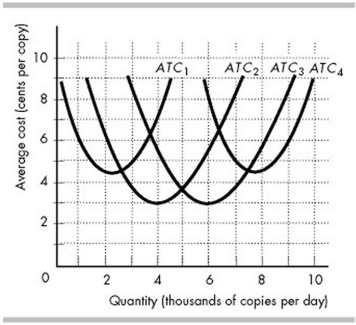
Dustin's copy shop can use four alternative plants. The figure above shows the average total cost curves for Plant 1 (ATC1), Plant 2 (ATC2), Plant 3 (ATC3), and Plant 4 (ATC4). What is Dustin's long- run average cost if the output is 3,000 copies per day?
A) 5.0 cents per copy
B) 8.5 cents per copy
C) 3.7 cents per copy
D) More information is needed to determine the long- run average cost.

Unlock Deck
Unlock for access to all 140 flashcards in this deck.
Unlock Deck
k this deck
59
If economic profit is equal to zero, then
A) the entrepreneur is earning only a normal profit.
B) the entrepreneur's profit cannot be determined based on the information given.
C) the entrepreneur's profit as measured by accountants is also equal to zero.
D) the entrepreneur's profit as measured by accountants must be less than zero.
A) the entrepreneur is earning only a normal profit.
B) the entrepreneur's profit cannot be determined based on the information given.
C) the entrepreneur's profit as measured by accountants is also equal to zero.
D) the entrepreneur's profit as measured by accountants must be less than zero.

Unlock Deck
Unlock for access to all 140 flashcards in this deck.
Unlock Deck
k this deck
60
A firm's total cost (TC) equals the sum of its fixed cost plus its
A) variable cost.
B) marginal cost.
C) variable cost plus its marginal cost.
D) sunk cost plus its variable cost plus its marginal cost.
A) variable cost.
B) marginal cost.
C) variable cost plus its marginal cost.
D) sunk cost plus its variable cost plus its marginal cost.

Unlock Deck
Unlock for access to all 140 flashcards in this deck.
Unlock Deck
k this deck
61
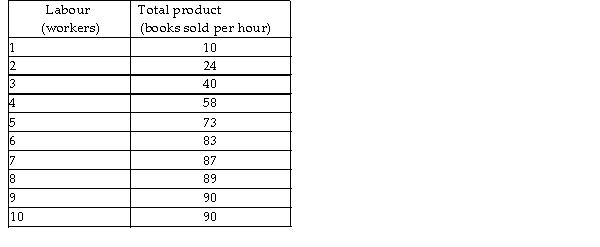
The above table shows the short- run total product schedule for the campus bookshop. What is the marginal product (MP) of going from 5 to 6 employees at the bookshop?
A) 10 books sold
B) 83 books sold
C) 13.83 books sold
D) Between 11 and 14 books sold

Unlock Deck
Unlock for access to all 140 flashcards in this deck.
Unlock Deck
k this deck
62
A normal profit for a self- employed entrepreneur is
I. an opportunity cost.
II. part of the implicit rental rate of the funds invested in the business.
A) Only I
B) Only II
C) Both I and II
D) Neither I nor II
I. an opportunity cost.
II. part of the implicit rental rate of the funds invested in the business.
A) Only I
B) Only II
C) Both I and II
D) Neither I nor II

Unlock Deck
Unlock for access to all 140 flashcards in this deck.
Unlock Deck
k this deck
63
Which of the following statements is true?
A) If marginal product equals average product, marginal product is at its maximum.
B) If marginal product equals average product, average product is at its maximum.
C) If marginal product exceeds average product, marginal product increases.
D) If average product equals marginal product, average product decreases.
A) If marginal product equals average product, marginal product is at its maximum.
B) If marginal product equals average product, average product is at its maximum.
C) If marginal product exceeds average product, marginal product increases.
D) If average product equals marginal product, average product decreases.

Unlock Deck
Unlock for access to all 140 flashcards in this deck.
Unlock Deck
k this deck
64
A cost that has already been made and cannot be recovered is called a
A) variable cost.
B) marginal cost.
C) fixed cost.
D) sunk cost.
A) variable cost.
B) marginal cost.
C) fixed cost.
D) sunk cost.

Unlock Deck
Unlock for access to all 140 flashcards in this deck.
Unlock Deck
k this deck
65

Sandra's Shirts' production function is shown in the above table. Sandra rents three knitting machines for $30 a day each and hires workers at a daily wage rate of $40 per worker. If Sandra produces 18 shirts per day, what is her average total cost?
A) $10.00
B) $5.00
C) $9.44
D) $6.67

Unlock Deck
Unlock for access to all 140 flashcards in this deck.
Unlock Deck
k this deck
66
After constructing a new factory, the cost of building the factory is a
A) sunk cost.
B) variable cost.
C) past cost.
D) None of the above answers is correct.
A) sunk cost.
B) variable cost.
C) past cost.
D) None of the above answers is correct.

Unlock Deck
Unlock for access to all 140 flashcards in this deck.
Unlock Deck
k this deck
67

The table above gives costs at Jan's Bike Shop. Unfortunately, Jan's record keeping has been patchy. Each worker is paid $100 a day. Labour costs are the only variable cost of production. What is the total cost of producing 50 bikes?
A) $200
B) $300
C) $400
D) $100

Unlock Deck
Unlock for access to all 140 flashcards in this deck.
Unlock Deck
k this deck
68
When the marginal product curve is downward- sloping, the average product curve
A) must be horizontal.
B) must also be downward- sloping.
C) must be upward- sloping.
D) might be either upward- or downward- sloping.
A) must be horizontal.
B) must also be downward- sloping.
C) must be upward- sloping.
D) might be either upward- or downward- sloping.

Unlock Deck
Unlock for access to all 140 flashcards in this deck.
Unlock Deck
k this deck
69
Average total costs are
A) the change in output divided by the change in total costs.
B) total costs divided by total output.
C) total output divided by total costs.
D) the change in total costs divided by the change in output.
A) the change in output divided by the change in total costs.
B) total costs divided by total output.
C) total output divided by total costs.
D) the change in total costs divided by the change in output.

Unlock Deck
Unlock for access to all 140 flashcards in this deck.
Unlock Deck
k this deck
70
As output increases, total cost _______ , total fixed cost _______, and total variable cost _______.
A) increases; increases; does not change
B) increases; does not change; increases
C) increases; increases; increases
D) does not change; increases; increases
A) increases; increases; does not change
B) increases; does not change; increases
C) increases; increases; increases
D) does not change; increases; increases

Unlock Deck
Unlock for access to all 140 flashcards in this deck.
Unlock Deck
k this deck
71
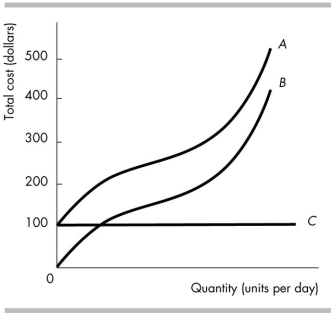
In the above figure, the relationship between costs indicates that the distance between curves
A) A and B is equal to the variable cost.
B) B and C is equal to the fixed cost.
C) B and C is equal to the average total cost.
D) A and B is equal to the fixed cost.

Unlock Deck
Unlock for access to all 140 flashcards in this deck.
Unlock Deck
k this deck
72
In the short run,
A) at least one factor of production is fixed.
B) all factors of production are fixed.
C) all factors of production are variable.
D) there are no variable costs.
A) at least one factor of production is fixed.
B) all factors of production are fixed.
C) all factors of production are variable.
D) there are no variable costs.

Unlock Deck
Unlock for access to all 140 flashcards in this deck.
Unlock Deck
k this deck
73

The table above shows the short- run product schedule for Virginia's T- Shirts. What is the average product associated with hiring the fourth worker?
A) 220 shirts
B) 40 shirts
C) 50 shirts
D) 55 shirts

Unlock Deck
Unlock for access to all 140 flashcards in this deck.
Unlock Deck
k this deck
74
Diseconomies of scale definitely mean that as the firm increases its output, its
A) long- run average total cost increases.
B) short- run average total cost increases.
C) long- run average total cost decreases.
D) short- run average total cost decreases.
A) long- run average total cost increases.
B) short- run average total cost increases.
C) long- run average total cost decreases.
D) short- run average total cost decreases.

Unlock Deck
Unlock for access to all 140 flashcards in this deck.
Unlock Deck
k this deck
75
Among the opportunity costs of a firm are all of the following EXCEPT
A) economic profits.
B) normal profits.
C) the owner's forgone wage.
D) the cost of resources bought in markets, such as labour.
A) economic profits.
B) normal profits.
C) the owner's forgone wage.
D) the cost of resources bought in markets, such as labour.

Unlock Deck
Unlock for access to all 140 flashcards in this deck.
Unlock Deck
k this deck
76

The above table shows the short- run total product schedule for the campus bookshop. When the bookshop hires the third employee,
A) marginal product is at its maximum.
B) both marginal and average product have already begun to decline.
C) the bookshop has already begun to experience diminishing marginal returns, but average product is still rising.
D) the bookshop is still experiencing increasing marginal returns.

Unlock Deck
Unlock for access to all 140 flashcards in this deck.
Unlock Deck
k this deck
77
If the average total cost of producing 20 sweaters an hour falls when the firm doubles all its inputs, then the
A) firm moves along its short- run average total cost curve.
B) short- run average total cost curve shifts upward because all inputs have increased.
C) long- run average cost curve shifts downward.
D) firm experiences economies of scale.
A) firm moves along its short- run average total cost curve.
B) short- run average total cost curve shifts upward because all inputs have increased.
C) long- run average cost curve shifts downward.
D) firm experiences economies of scale.

Unlock Deck
Unlock for access to all 140 flashcards in this deck.
Unlock Deck
k this deck
78
Sheila's Sports Shop is a very popular sporting goods store, which has yearly revenue of $600,000. Sheila runs the business herself. Her alternative employment options are to be a university swimming coach for $50,000 per year or a construction worker for $40,000 per year. Sheila spends
$230,000 purchasing goods for resale to her customers. She also has four employees, who each earn
$25,000 per year. Sheila owns the building that her Sports Shop is housed in and she could have rented it out for $20,000 per year. Sheila's economic profit is equal to
A) $250,000 per year.
B) $160,000 per year.
C) $270,000 per year.
D) $200,000 per year.
$230,000 purchasing goods for resale to her customers. She also has four employees, who each earn
$25,000 per year. Sheila owns the building that her Sports Shop is housed in and she could have rented it out for $20,000 per year. Sheila's economic profit is equal to
A) $250,000 per year.
B) $160,000 per year.
C) $270,000 per year.
D) $200,000 per year.

Unlock Deck
Unlock for access to all 140 flashcards in this deck.
Unlock Deck
k this deck
79
An electrician quits her current job, which pays $40,000 per year. She can take a job with another firm for $45,000 per year or work for herself. The opportunity cost of working for herself is
A) $40,000.
B) $45,000.
C) $85,000.
D) $5,000.
A) $40,000.
B) $45,000.
C) $85,000.
D) $5,000.

Unlock Deck
Unlock for access to all 140 flashcards in this deck.
Unlock Deck
k this deck
80
A firm's long- run cost is the cost of production when the firm
A) uses the economically efficient quantities of all of its factors of production.
B) can vary the amount of output it produces.
C) calculates its cost at least one year into the future.
D) adds together all of its short- run costs.
A) uses the economically efficient quantities of all of its factors of production.
B) can vary the amount of output it produces.
C) calculates its cost at least one year into the future.
D) adds together all of its short- run costs.

Unlock Deck
Unlock for access to all 140 flashcards in this deck.
Unlock Deck
k this deck



